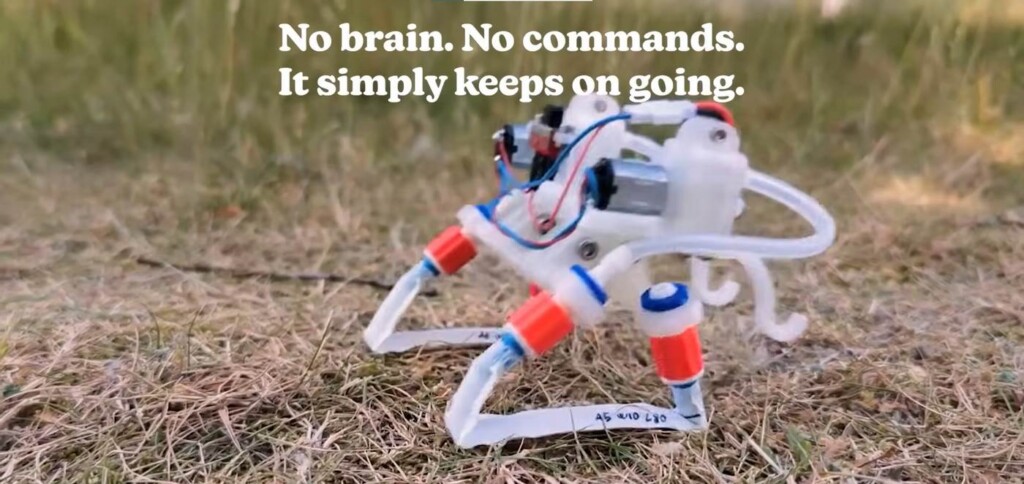 – credit AMOLF Institute, The Netherlands
– credit AMOLF Institute, The NetherlandsA Dutch robot with neither hardware nor software can nevertheless reach incredible speeds with its soft legs powered only by air and simple physics.
Able to walk, hop, and swim without the aid of electronics or AI, its top speed will see it cross a distance equal to 30x the length of its body in a single second, about 100% faster than a Ferrari when speaking relatively.
Engineers at the AMOLF research institute in Amsterdam explained that the robot works on the same principle as the wobbly, inflatable tube dancers that flail around outside automotive dealerships. They say the same physics that makes them wiggle could hold the key to the next generation of autonomous robots.
“Soft robotics” has seen major advances of late in creating controllable units with minimal or zero electronic or mechanical components. These have included flabby “gel bots” that move inchworm-like through changes in temperature.
Powered by a continuous stream of air alone, each of the AWOLF robot’s soft, tubular legs begins to oscillate—not unlike those tube dancers.
But when many legs are coupled together, something unexpected happens: their motions quickly synchronize, creating “surprising coordination and autonomy” simply because of its body and how it interacts with the world, according to a study published in the journal Science.
“There’s no code, no instructions,” said study first author Alberto Comoretto. “The legs simply fall into sync spontaneously, and the robot takes off. Suddenly, order emerges from chaos.”
After the legs synchronize, the robot hits 30 body lengths per second when air is delivered at high speeds.
Comoretto, a PhD student in soft robotic matter, says that, relatively speaking, a Ferrari reaches only 20 lengths per second. This is the same logic as saying a flea can jump farther than a frog, or a spider is stronger than Arnold Schwarzenegger.
The better comparison is to other air-powered robots, which typically require centralized control, and travel “orders of magnitude” slower.
Perhaps the robot’s best party trick is revealed when it runs into an obstacle: it simply scrambles for a moment before reorganizing its legs, not unlike a millipede does when it is knocked out of rhythm.
“When it moves from land to water, the gait spontaneously shifts from an in-phase hopping pattern to a swimming freestyle,” said Comoretto. “These transitions happen without any central processor or control logic.”
A MUSHROOM RATHER THAN A BRAIN: Watch This Mushroom Propel a Robot Across the Ground—We’re Not Joking
Study co-author Dr. Mannus Schomaker compared it to the movement of sea stars, or other animals with limited or no cognitive experience.
“In biology, we often see similar decentralized intelligence,” said Dr. Schomaker. “Sea stars, for example, coordinate hundreds of tube feet using local feedback and body dynamics, not a centralized brain.”
Principal investigator Professor Bas Overvelde said that he doesn’t even feel it’s appropriate to call it a robot, explaining that “essentially, it’s a machine.”
OTHER SOFT ROBOTS: Tiny Scaled Robot Inspired by a Pangolin Can Roll About and Could Deliver Lifesaving Medications
“But when properly designed, it can outperform many robotic systems and behave like an artificial creature,” he added.
The researchers say possible future applications range from smart pills to space tech—for example reconnaissance of other worlds where little is known about the surface.
So much of early research and imagination into robotics and robots was informed by human biology. In reality, there are dozens of forms of locomotion found in nature, and soft robotics as a field is demonstrating how useful many of these can be in designing intelligent or controllable machines to tackle the challenges of today and tomorrow.
WATCH it go in the video below…
SHARE This Amazing Robot’s Ability To Move About With Your Friends…
Source link

